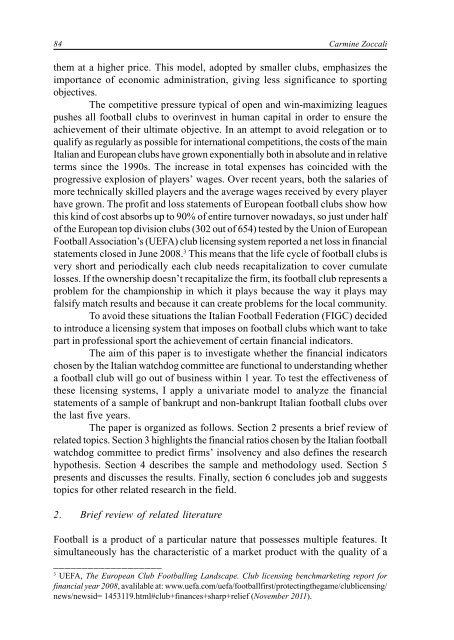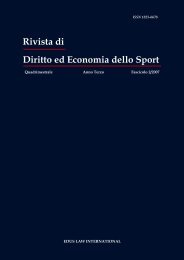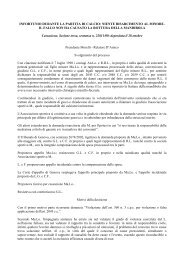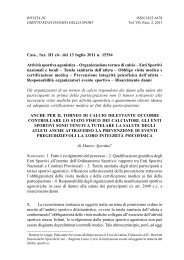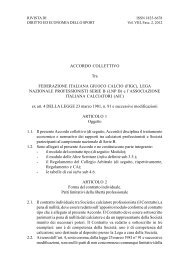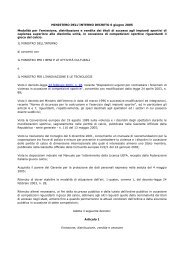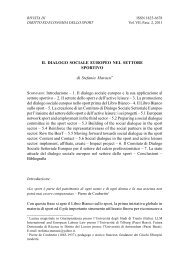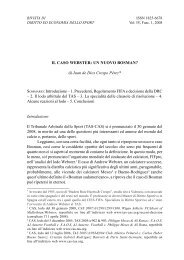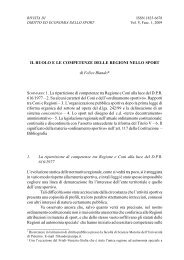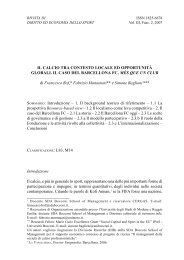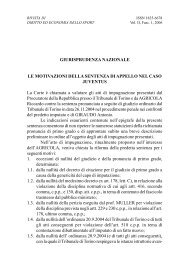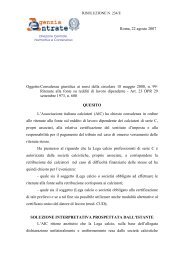Scarica il fascicolo completo - Rdes.It
Scarica il fascicolo completo - Rdes.It
Scarica il fascicolo completo - Rdes.It
Create successful ePaper yourself
Turn your PDF publications into a flip-book with our unique Google optimized e-Paper software.
84 Carmine Zoccali<br />
them at a higher price. This model, adopted by smaller clubs, emphasizes the<br />
importance of economic administration, giving less significance to sporting<br />
objectives.<br />
The competitive pressure typical of open and win-maximizing leagues<br />
pushes all football clubs to overinvest in human capital in order to ensure the<br />
achievement of their ultimate objective. In an attempt to avoid relegation or to<br />
qualify as regularly as possible for international competitions, the costs of the main<br />
<strong>It</strong>alian and European clubs have grown exponentially both in absolute and in relative<br />
terms since the 1990s. The increase in total expenses has coincided with the<br />
progressive explosion of players’ wages. Over recent years, both the salaries of<br />
more technically sk<strong>il</strong>led players and the average wages received by every player<br />
have grown. The profit and loss statements of European football clubs show how<br />
this kind of cost absorbs up to 90% of entire turnover nowadays, so just under half<br />
of the European top division clubs (302 out of 654) tested by the Union of European<br />
Football Association’s (UEFA) club licensing system reported a net loss in financial<br />
statements closed in June 2008. 3 This means that the life cycle of football clubs is<br />
very short and periodically each club needs recapitalization to cover cumulate<br />
losses. If the ownership doesn’t recapitalize the firm, its football club represents a<br />
problem for the championship in which it plays because the way it plays may<br />
falsify match results and because it can create problems for the local community.<br />
To avoid these situations the <strong>It</strong>alian Football Federation (FIGC) decided<br />
to introduce a licensing system that imposes on football clubs which want to take<br />
part in professional sport the achievement of certain financial indicators.<br />
The aim of this paper is to investigate whether the financial indicators<br />
chosen by the <strong>It</strong>alian watchdog committee are functional to understanding whether<br />
a football club w<strong>il</strong>l go out of business within 1 year. To test the effectiveness of<br />
these licensing systems, I apply a univariate model to analyze the financial<br />
statements of a sample of bankrupt and non-bankrupt <strong>It</strong>alian football clubs over<br />
the last five years.<br />
The paper is organized as follows. Section 2 presents a brief review of<br />
related topics. Section 3 highlights the financial ratios chosen by the <strong>It</strong>alian football<br />
watchdog committee to predict firms’ insolvency and also defines the research<br />
hypothesis. Section 4 describes the sample and methodology used. Section 5<br />
presents and discusses the results. Finally, section 6 concludes job and suggests<br />
topics for other related research in the field.<br />
2. Brief review of related literature<br />
Football is a product of a particular nature that possesses multiple features. <strong>It</strong><br />
simultaneously has the characteristic of a market product with the quality of a<br />
___________________<br />
3 UEFA, The European Club Footballing Landscape. Club licensing benchmarketing report for<br />
financial year 2008, aval<strong>il</strong>able at: www.uefa.com/uefa/footballfirst/protectingthegame/clublicensing/<br />
news/newsid= 1453119.html#club+finances+sharp+relief (November 2011).


